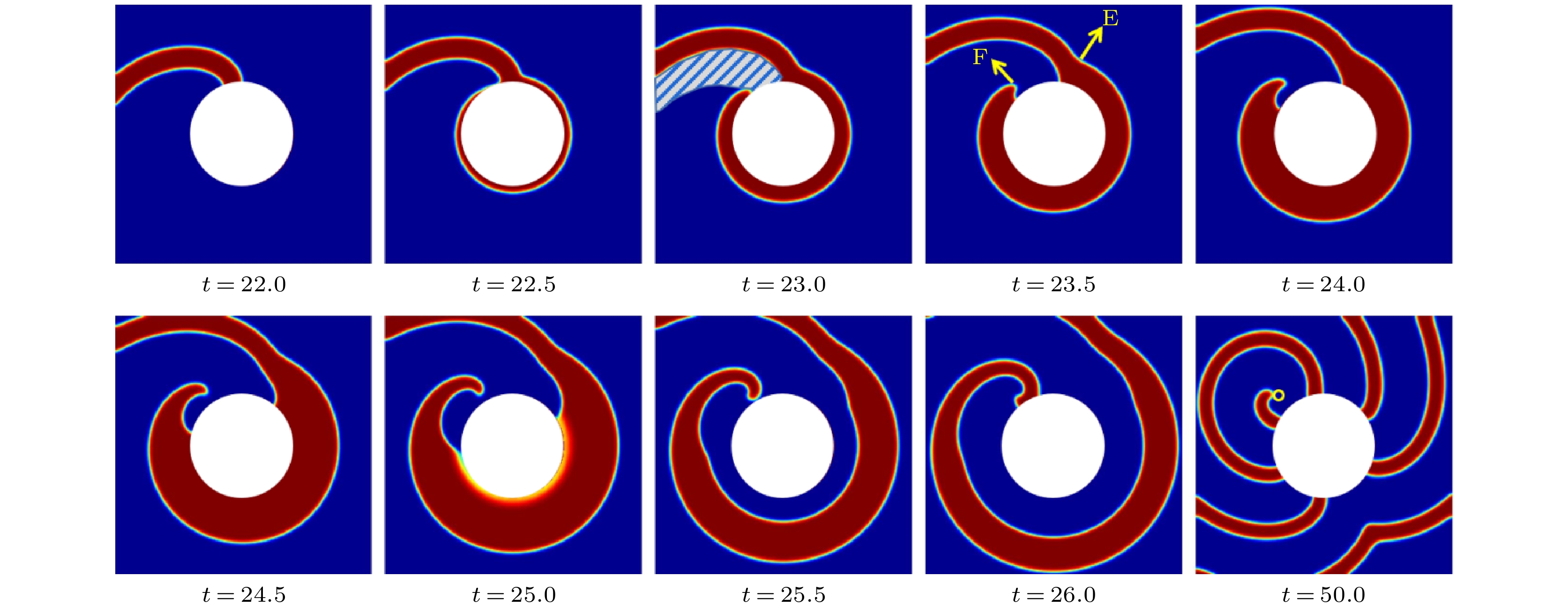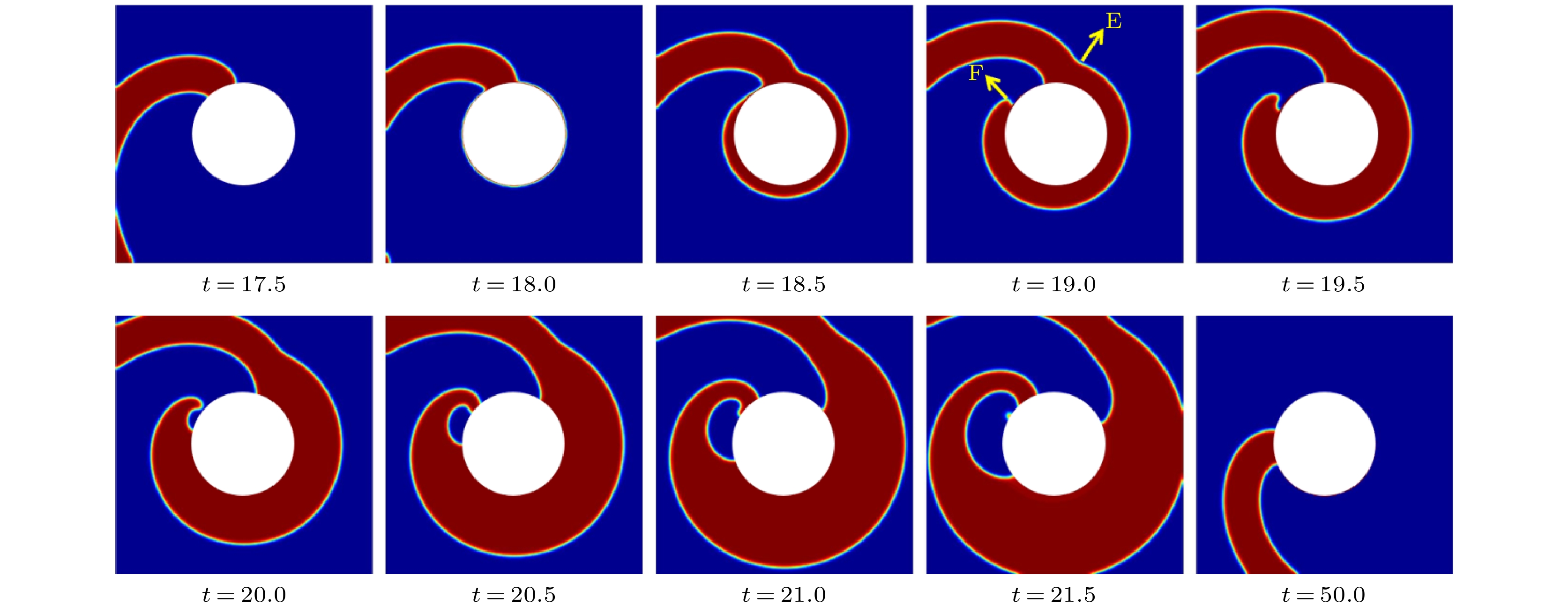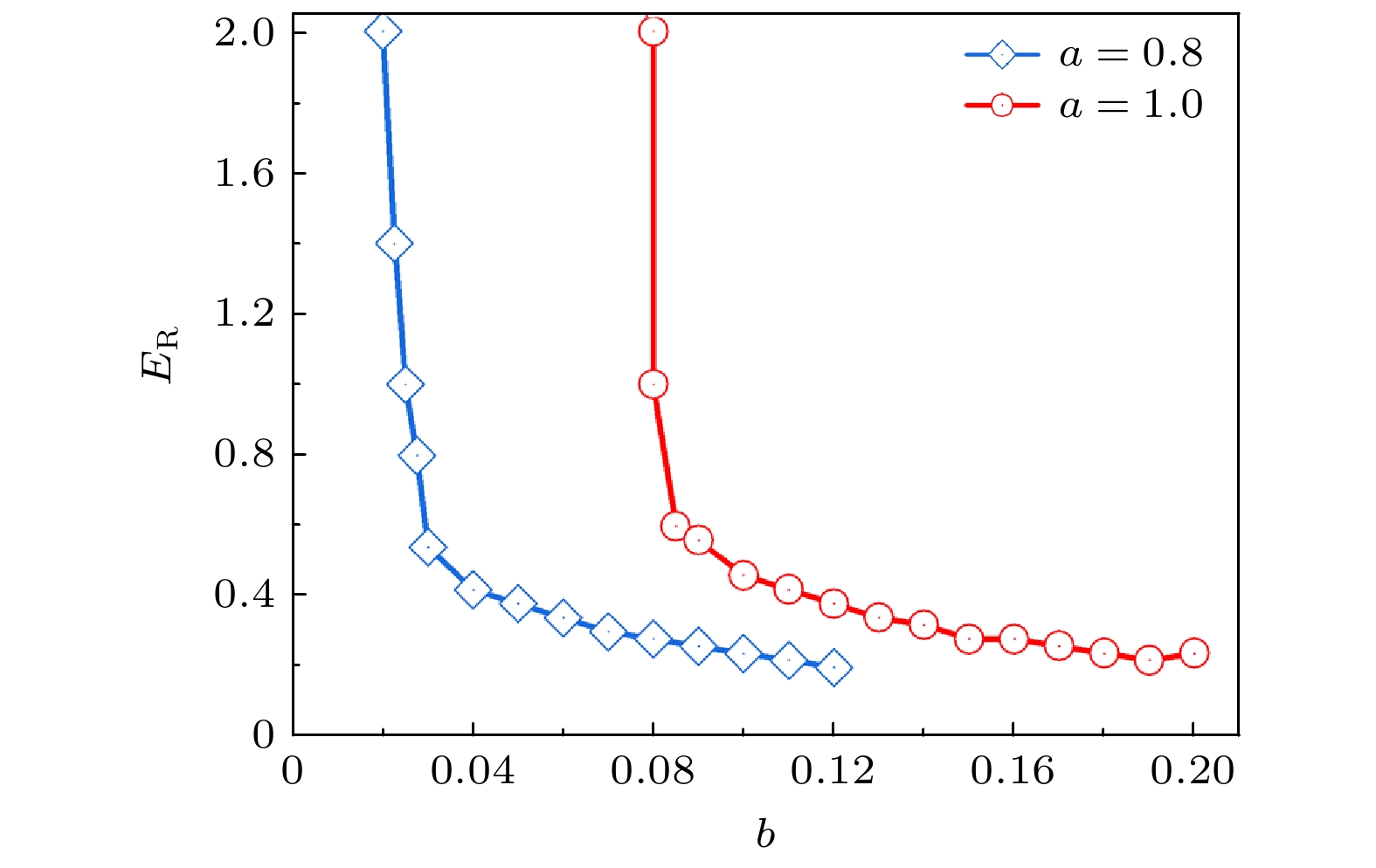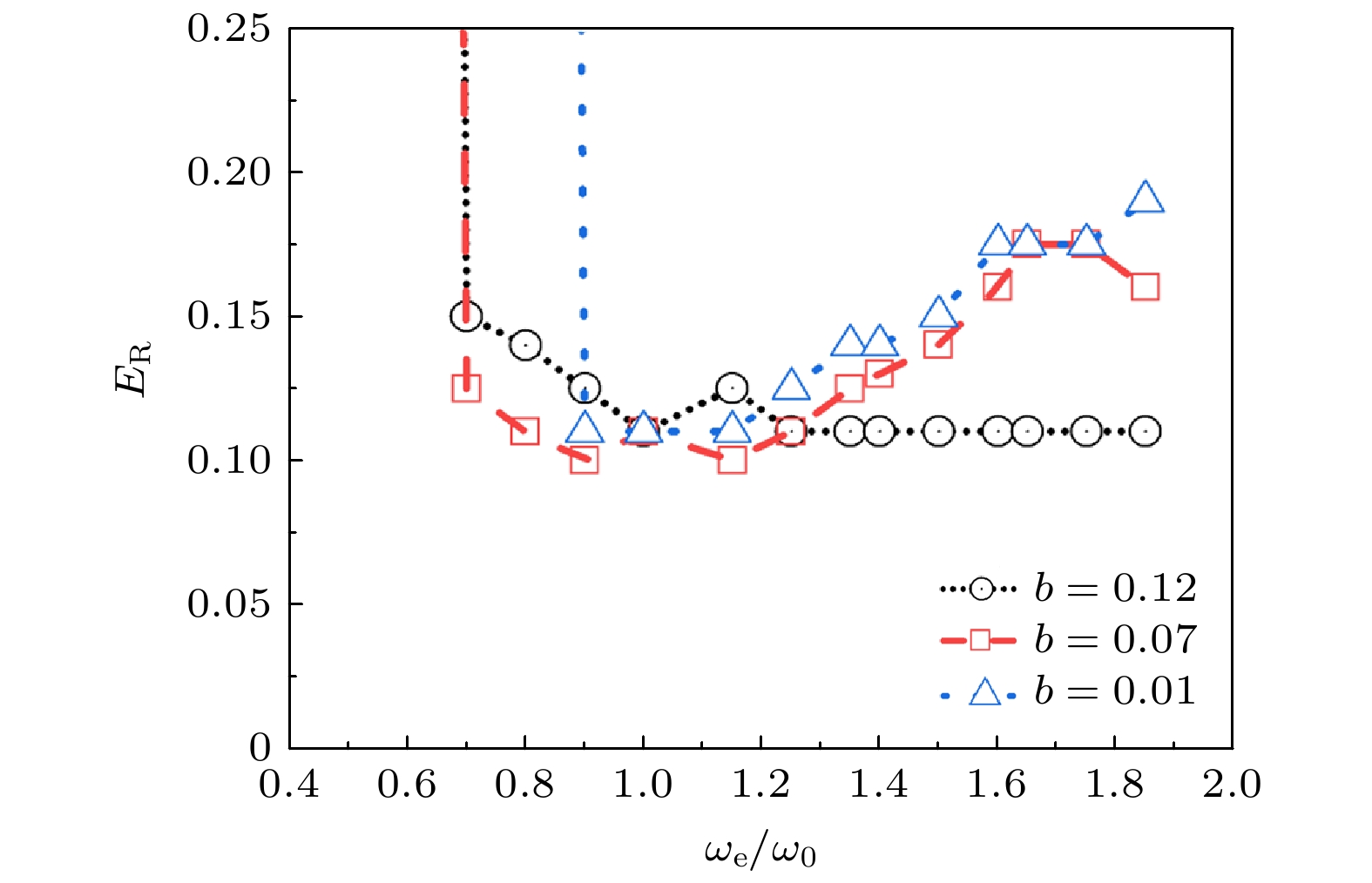-
采用Barkley模型研究了径向电脉冲对可激发介质中螺旋波脱钉的影响. 数值模拟结果表明, 径向电脉冲可成功地帮助螺旋波从缺陷上脱钉. 单次径向电脉冲可以在弱激发区域成功地帮助螺旋波从缺陷上脱钉, 但在激发性强的介质中则不能帮助螺旋波实现脱钉. 单次径向电脉冲的脱钉参数空间大于均匀电场和抗心动过速起搏方法的脱钉参数空间. 多次径向电脉冲可在可激发介质中整个螺旋波存在的参数空间脱钉. 对比其他使用电场脱钉的方法, 采用径向电脉冲方法脱钉具有电场强度低、成功率高和脱钉参数空间大等优点. 并且采用本方法脱钉时, 其成功率对螺旋波在缺陷上的钉扎相位不敏感. 我们希望本方法能为临床中治疗相关心脏疾病提供一种新思路.In this paper, the process of unpinning spiral waves from obstacles with pulses of radial electrical field (PREF) in excitable medium is studied by using Barkley model. We use a radial electrical field to simulate the field of an needle electrode placed in the middle of a round obstacle. Numerical results show that the PREF can separate spiral waves from obstacles effectively. With a single pulse of radial electrical field (SPREF), spiral waves can be unpinned from an obstacle effectively in a weakly excitable medium, but it cannot be unpinned in a strongly excitable medium. The unpinning parameter space of an SPREF is larger than that of a uniform electric field or anti-tachycardia pacing. Multiple pulses of radial electrical field (MPREF) is effective for unpinning in the entire parameter space where spiral waves exist. Compared with other methods to unpin spiral waves, the PREF method has the advantages of low electric field magnitude, high success rate, and large application range in the parameter space. And unlike other methods, the PREF has a success rate insensitive to the phase of the spiral wave on the obstacle. We hope that this method will provide a new idea for clinical treatment for related cardiac diseases.
-
Keywords:
- spiral wave /
- unpin /
- obstacle /
- excitable medium
[1] Frisch T, Rica S, Coullet P, Gilli J M 1994 Phys. Rev. Lett. 72 1471
 Google Scholar
Google Scholar
[2] Plapp B B, Egolf D A, Bodenschatz E, Pesch W 1998 Phys. Rev. Lett. 81 5334
 Google Scholar
Google Scholar
[3] Jakubith S, Rotermund H H, Engel W, Von Oertzen A, Ertl G 1900 Phys. Rev. Lett. 65 3013
[4] Plesser T, Mueller S C, Hess B 1990 J. Phys. Chem. 94 7501
 Google Scholar
Google Scholar
[5] Steinbock O, Zykov V, Müller S C 1993 Nature 366 322
 Google Scholar
Google Scholar
[6] Witkowski F X, Leon L J, Penkoske P A, Giles W R, Spano M L, Ditto W L, Winfree A T 1998 Nature 392 78
 Google Scholar
Google Scholar
[7] Holden A V 1998 Nature 392 20
 Google Scholar
Google Scholar
[8] Detal N, Kaboudian A, Fenton F 2021 PANS 119 24
[9] Wang Q, Perc M, Duan Z, Chen G 2008 Phys. Lett. A 372 5681
 Google Scholar
Google Scholar
[10] 周振玮, 陈醒基, 田涛涛, 唐国宁 2012 物理学报 61 210506
 Google Scholar
Google Scholar
Zhou Z W, Chen X J, Tian T T, Tang G N 2012 Acta Phys. Sin. 61 210506
 Google Scholar
Google Scholar
[11] 马军, 谢振博, 陈江星 2012 物理学报 61 038701
 Google Scholar
Google Scholar
Ma J, Xie Z B, Chen J X 2012 Acta Phys. Sin. 61 038701
 Google Scholar
Google Scholar
[12] 王春妮, 马军 2013 物理学报 62 084501
 Google Scholar
Google Scholar
Wang C N, Ma J 2013 Acta Phys. Sin. 62 084501
 Google Scholar
Google Scholar
[13] 徐莹, 王春妮, 靳伍银, 马军 2015 物理学报 64 198701
 Google Scholar
Google Scholar
Xu Y, Wang C N, Jin W Y, Ma J 2015 Acta Phys. Sin. 64 198701
 Google Scholar
Google Scholar
[14] 李倩昀, 黄志精, 唐国宁 2018 物理学报 67 248201
 Google Scholar
Google Scholar
Li Q Y, Huang Z J, Tang G N 2018 Acta Phys. Sin. 67 248201
 Google Scholar
Google Scholar
[15] Zhou M G, Wang H D, Zeng X Y, Zhu J, Chen W, Liang X 2019 The Lancet 394 1145
 Google Scholar
Google Scholar
[16] Zhang H, Cao Z, Wu N J, Ying H P, Hu G 2005 Phys. Rev. Lett. 94 188301
 Google Scholar
Google Scholar
[17] Fenton F H, Luther S, Cherry E M, Otani N F, Krinsky V, Pumir A, Gilmour R F 2009 Circulation 120 467
 Google Scholar
Google Scholar
[18] Bittihn P 2015 Ph. D. Dissertation (Göttingen: the University of Göttingen)
[19] Panchangam S, Monahan K M, Helm R H 2022 Curr. Treat. Option. Cardiovasc. Med. 24 27
 Google Scholar
Google Scholar
[20] Tina L, Andreas R, Tudor B, Andreas M, Shibu M, Erik W, Peter W, Heinz K K, Feifan O Y, Roland R T 2015 Europace:Eur. Pacing 17 1791
[21] Li Q H, Van Nieuwenhuyse E, Xia Y X, Pan J T, Duytschaever M, Knecht S, Vandersickel, Zhou C, Panfilov A V, Zhang H 2021 Phys. Rev. E 104 064401
[22] Nieuwenhuyse E V, Strisciuglio T, Lorenzo G, Haddad M E, Vandersickel N 2021 Clin. Electrophysiol. 7 936
 Google Scholar
Google Scholar
[23] Barkley D 1991 Physica D 49 61
 Google Scholar
Google Scholar
[24] Bittihn P, Luther G, Bodenschatz E, krinsky V, Parlitz U, Luther S 2008 New J. Phys. 10 103012
 Google Scholar
Google Scholar
[25] Chen J X, Peng L, Ma J, Ying H P 2014 Europhys. Lett. 107 38001
 Google Scholar
Google Scholar
[26] Feng X, Gao X, Pan D B, Li B W, Zhang H 2014 Sci. Rep. 4 4831
[27] Punacha S, Kumara A N, Shajahan T K 2020 Phys. Rev. E 102 032411
[28] Bittihn P, Squires A, Luther G, Bodenschatz E, Krinsky V, Parlitz U, Luther S 2010 Philos. Trans. R. Soc. London, Ser. A 368 2221
-
图 1 SPREF使螺旋波成功脱钉的过程(此时系统参数
$ a=0.8 $ ,$ b=0.07 $ , 缺陷半径$ {R}_{{\rm{h}}}=10 $ . 在$ t=22 $ 时刻加入强度$ {E}_{0}=4.0 $ 的SPREF, 电场持续时间$ {t}_{{\rm{D}}}=0.6 $ )Fig. 1. A successful unpinning process with SPREF. The parameters used are
$ a=0.8 $ ,$ b=0.07 $ . The radius of the obstacle$ {R}_{{\rm{h}}}=10 $ . A SPREF with magnitude$ {E}_{0}=4.0 $ is applied at$ t=22 $ and lasts for$ {t}_{{\rm{D}}}=0.6 $ .图 3 最小电场在缺陷边界处的强度
$ {E}_{{\rm{R}}} $ 随系统参数$ b $ 变化的曲线(其他参数为$ a=0.8 $ ,$ {R}_{{\rm{h}}}=10 $ ,$ {t}_{{\rm{D}}}=0.6 $ )Fig. 3. The minimum electric field magnitude at the boundary of the obstacle
$ {E}_{{\rm{R}}} $ varies with the system parameter$ b $ . Other parameters are$ a=0.8 $ ,$ {R}_{{\rm{h}}}=10 $ ,$ {t}_{{\rm{D}}}=0.6 $ .图 4 PREF方法可以使螺旋波成功脱钉的参数空间. I区域为UEF的脱钉参数区域, I + II区域为SPREF的脱钉参数区域, I + II + III区域为MPREF的脱钉参数区域. NW表示此参数区域不存在波斑图, RW表示此参数区域不存在螺旋波, SW表示此参数区域存在螺旋波, BI表示双稳态
Fig. 4. Parameter space in which spiral waves can be unpinned with PREF. Area I is the unpinning parameter area of UEF, area I + II is the unpinning parameter area of SPREF, and area I + II + III is the unpinning parameter area of MPREF. The NW, RW, SW and BI regions represent no wave, retracting waves, spiral waves, and bi-stability respectively.
图 5 MPREF使螺旋波成功脱钉的过程(系统参数
$ a=0.8 $ ,$ b=0.01 $ ,$ {R}_{{\rm{h}}}=10 $ ,$ {\omega }_{{\rm{e}}}={\omega }_{0} $ ,$ {\omega }_{0}=2.03 $ ,$ {E}_{0}=5 $ )Fig. 5. A successful unpinning process with MPREF. The parameters are
$ a=0.8 $ ,$ b=0.01 $ ,$ {R}_{{\rm{h}}}=10 $ ,$ {\omega }_{{\rm{e}}}={\omega }_{0} $ ,$ {\omega }_{0}=2.03 $ ,$ {E}_{0}=5 $ .图 6 可使螺旋波脱钉的最小电场在缺陷边界处的强度
$ {E}_{{\rm{R}}} $ 随电场频率变化的曲线(此时系统参数$ a=0.8 $ ,${R}_{{\rm{h}}}= $ $ 10$ )Fig. 6. Magnitude of the minimum electric fields
$ {E}_{{\rm{R}}} $ at the boundary of the obstacle needed for unpinning varies with the angular frequency of MPREF. Other parameters are$ a=0.8 $ ,$ {R}_{{\rm{h}}}=10 $ .图 7 (a) 缺陷半径与临界电场强度关系图, 其中
$ {E}_{{\rm{R}}} $ 表示径向电场在缺陷边界处的强度,$ {E}_{0} $ 表示中心电场强度, 系统参数$ a=0.8 $ ,$ b=0.02 $ ,$ {\omega }_{{\rm{e}}}={\omega }_{0} $ ; (b) 临界电场在缺陷边界处的强度$ {E}_{{\rm{R}}} $ 与系统参数$ b $ 关系图, 系统参数$ a=0.8 $ ,$ {R}_{{\rm{h}}}=10 $ ,$ {\omega }_{{\rm{e}}}={\omega }_{0} $ Fig. 7. (a) Relationship between obstacle radius and the magnitude of MPREF.
$ {E}_{{\rm{R}}} $ stands for the magnitude of the field at the boundary of the obstacle, and$ {E}_{0} $ is the magnitude of the field in the center of the obstacle. The parameters used are$ a=0.8 $ ,$ b=0.02 $ ,$ {\omega }_{{\rm{e}}}={\omega }_{0} $ . (b) Relationship between critical electric field magnitude at the boundary of the obstacle$ {E}_{{\rm{R}}} $ and system parameters$ b $ . Other parameters are$ a=0.8 $ ,$ {R}_{{\rm{h}}}=10 $ ,$ {\omega }_{{\rm{e}}}={\omega }_{0} $ . -
[1] Frisch T, Rica S, Coullet P, Gilli J M 1994 Phys. Rev. Lett. 72 1471
 Google Scholar
Google Scholar
[2] Plapp B B, Egolf D A, Bodenschatz E, Pesch W 1998 Phys. Rev. Lett. 81 5334
 Google Scholar
Google Scholar
[3] Jakubith S, Rotermund H H, Engel W, Von Oertzen A, Ertl G 1900 Phys. Rev. Lett. 65 3013
[4] Plesser T, Mueller S C, Hess B 1990 J. Phys. Chem. 94 7501
 Google Scholar
Google Scholar
[5] Steinbock O, Zykov V, Müller S C 1993 Nature 366 322
 Google Scholar
Google Scholar
[6] Witkowski F X, Leon L J, Penkoske P A, Giles W R, Spano M L, Ditto W L, Winfree A T 1998 Nature 392 78
 Google Scholar
Google Scholar
[7] Holden A V 1998 Nature 392 20
 Google Scholar
Google Scholar
[8] Detal N, Kaboudian A, Fenton F 2021 PANS 119 24
[9] Wang Q, Perc M, Duan Z, Chen G 2008 Phys. Lett. A 372 5681
 Google Scholar
Google Scholar
[10] 周振玮, 陈醒基, 田涛涛, 唐国宁 2012 物理学报 61 210506
 Google Scholar
Google Scholar
Zhou Z W, Chen X J, Tian T T, Tang G N 2012 Acta Phys. Sin. 61 210506
 Google Scholar
Google Scholar
[11] 马军, 谢振博, 陈江星 2012 物理学报 61 038701
 Google Scholar
Google Scholar
Ma J, Xie Z B, Chen J X 2012 Acta Phys. Sin. 61 038701
 Google Scholar
Google Scholar
[12] 王春妮, 马军 2013 物理学报 62 084501
 Google Scholar
Google Scholar
Wang C N, Ma J 2013 Acta Phys. Sin. 62 084501
 Google Scholar
Google Scholar
[13] 徐莹, 王春妮, 靳伍银, 马军 2015 物理学报 64 198701
 Google Scholar
Google Scholar
Xu Y, Wang C N, Jin W Y, Ma J 2015 Acta Phys. Sin. 64 198701
 Google Scholar
Google Scholar
[14] 李倩昀, 黄志精, 唐国宁 2018 物理学报 67 248201
 Google Scholar
Google Scholar
Li Q Y, Huang Z J, Tang G N 2018 Acta Phys. Sin. 67 248201
 Google Scholar
Google Scholar
[15] Zhou M G, Wang H D, Zeng X Y, Zhu J, Chen W, Liang X 2019 The Lancet 394 1145
 Google Scholar
Google Scholar
[16] Zhang H, Cao Z, Wu N J, Ying H P, Hu G 2005 Phys. Rev. Lett. 94 188301
 Google Scholar
Google Scholar
[17] Fenton F H, Luther S, Cherry E M, Otani N F, Krinsky V, Pumir A, Gilmour R F 2009 Circulation 120 467
 Google Scholar
Google Scholar
[18] Bittihn P 2015 Ph. D. Dissertation (Göttingen: the University of Göttingen)
[19] Panchangam S, Monahan K M, Helm R H 2022 Curr. Treat. Option. Cardiovasc. Med. 24 27
 Google Scholar
Google Scholar
[20] Tina L, Andreas R, Tudor B, Andreas M, Shibu M, Erik W, Peter W, Heinz K K, Feifan O Y, Roland R T 2015 Europace:Eur. Pacing 17 1791
[21] Li Q H, Van Nieuwenhuyse E, Xia Y X, Pan J T, Duytschaever M, Knecht S, Vandersickel, Zhou C, Panfilov A V, Zhang H 2021 Phys. Rev. E 104 064401
[22] Nieuwenhuyse E V, Strisciuglio T, Lorenzo G, Haddad M E, Vandersickel N 2021 Clin. Electrophysiol. 7 936
 Google Scholar
Google Scholar
[23] Barkley D 1991 Physica D 49 61
 Google Scholar
Google Scholar
[24] Bittihn P, Luther G, Bodenschatz E, krinsky V, Parlitz U, Luther S 2008 New J. Phys. 10 103012
 Google Scholar
Google Scholar
[25] Chen J X, Peng L, Ma J, Ying H P 2014 Europhys. Lett. 107 38001
 Google Scholar
Google Scholar
[26] Feng X, Gao X, Pan D B, Li B W, Zhang H 2014 Sci. Rep. 4 4831
[27] Punacha S, Kumara A N, Shajahan T K 2020 Phys. Rev. E 102 032411
[28] Bittihn P, Squires A, Luther G, Bodenschatz E, Krinsky V, Parlitz U, Luther S 2010 Philos. Trans. R. Soc. London, Ser. A 368 2221
计量
- 文章访问数: 5582
- PDF下载量: 68
- 被引次数: 0


























 下载:
下载:

























































